Scroll down for Campus Bird Count results
Great Backyard Bird Count Results
Summary
GBBC 2021 was perhaps the most memorable Great Backyard Bird Count (GBBC) to date in India!
During the 4-day event of the GBBC, birders across the world take time out to watch birds and record the birds they see and hear. Since GBBC is carried out at around the same time of the year in February, it helps to create an annual real-time snapshot of bird distributions. Many tens of thousands of birdwatchers participate in this event every year, with GBBC serving as a wonderful catalyst to introduce new people to birds and birdwatching. This was the ninth year of GBBC in India.
Just like previous years, this GBBC in India also saw a considerable increase in the number of birders, checklists, and the number of person-hours spent birding from previous editions. In India, 2954 birders uploaded 31,355 lists clocking close to 17,000 hours of birding and recording an impressive 965 species–72 % of the total number of species known to occur in the country! Can we hit 1000 next year? A nice challenge for all birders across the country. Almost 1000 (50%) more birders from 30% more districts participated this year compared to the last, making this event a remarkable success. A big thank you to all state coordinators and to everyone who organised bird walks, talks on campuses and elsewhere in the country. We are grateful to all data quality reviewers who reviewed all observations in such a short span of time.
| GBBC 2021 | GBBC 2020 | |
| Participants | 2,954 | 2,018 |
| Lists | 31,355 | 24,966 |
| Species | 952 | 924 |
| Districts | 400 | 309 |
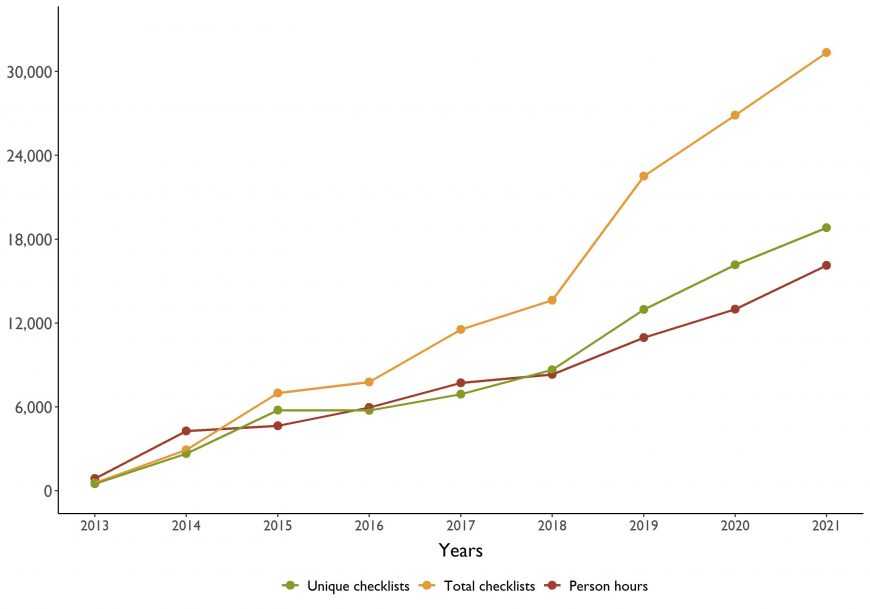
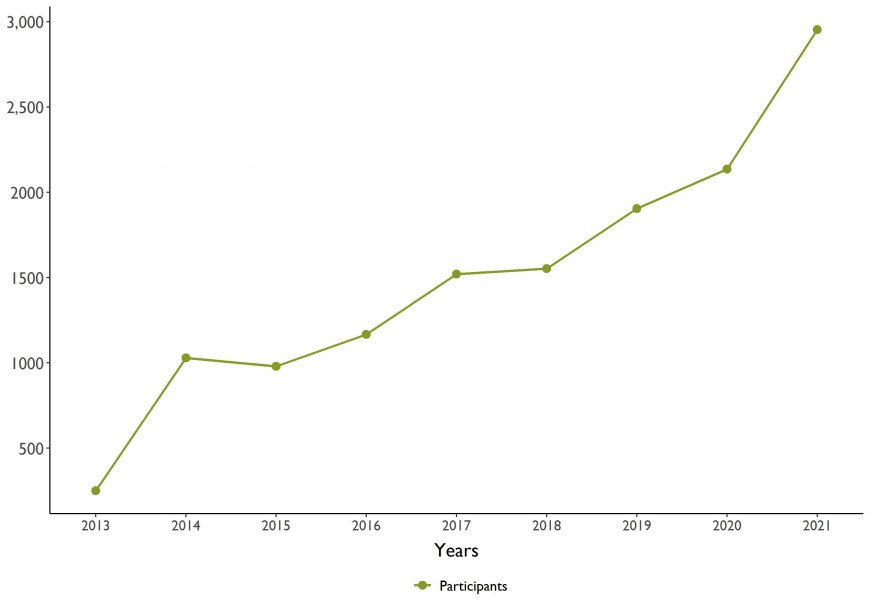
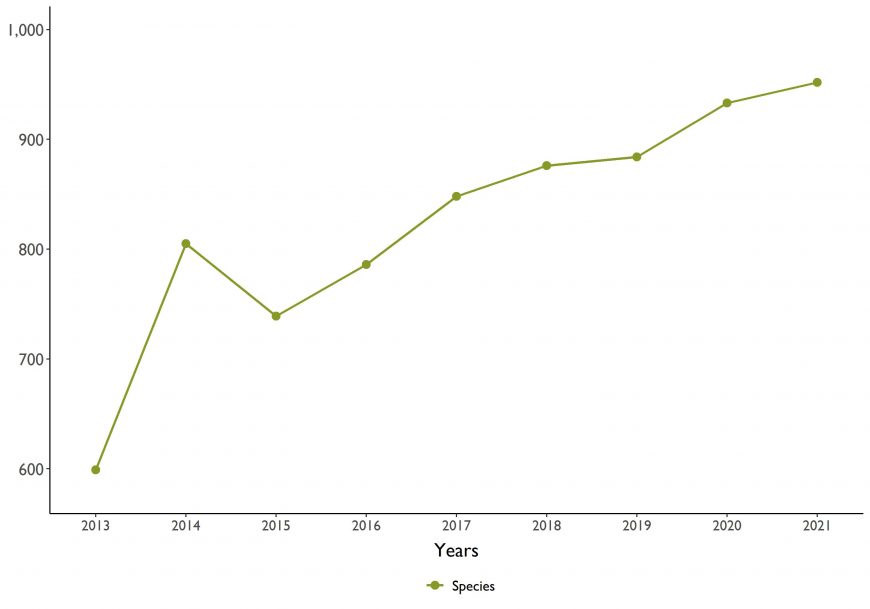
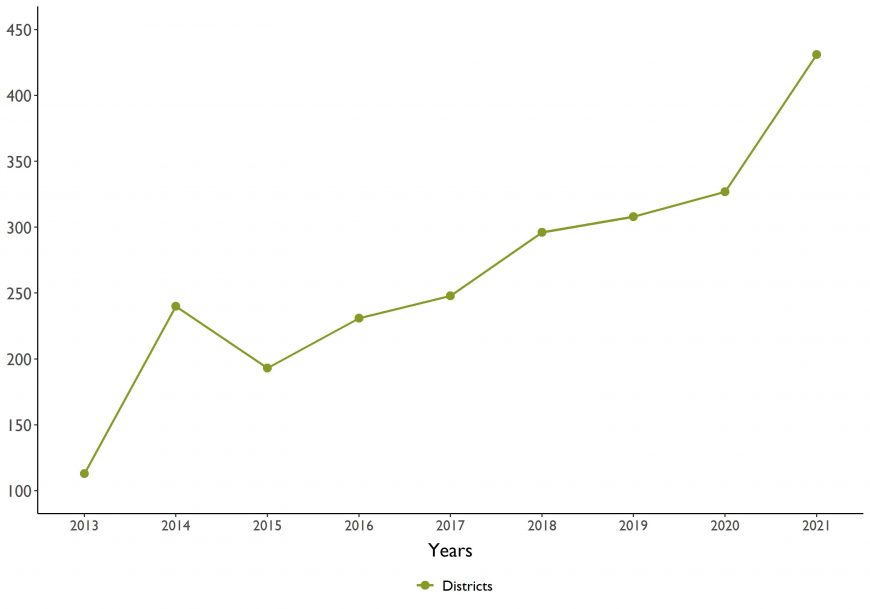
GBBC Global
In 2020, India was fourth globally in terms of the number of species reported, behind Colombia, Ecuador, and Brazil. This year India has risen to the second position behind Columbia based on the number of species reported. Similar to last year, this year too India ranked third behind the United States and Canada in terms of checklists uploaded. But we have almost caught up with Canada! We hope that even more participation next will see India moving into 2nd place!
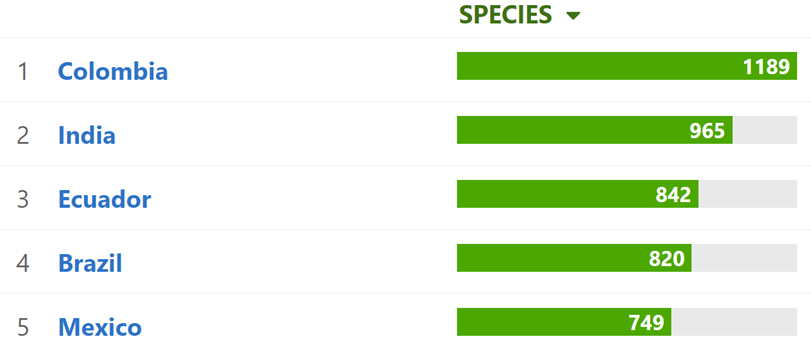
The number of species shown here differs from that shown in this article, as sensitive species are not included.
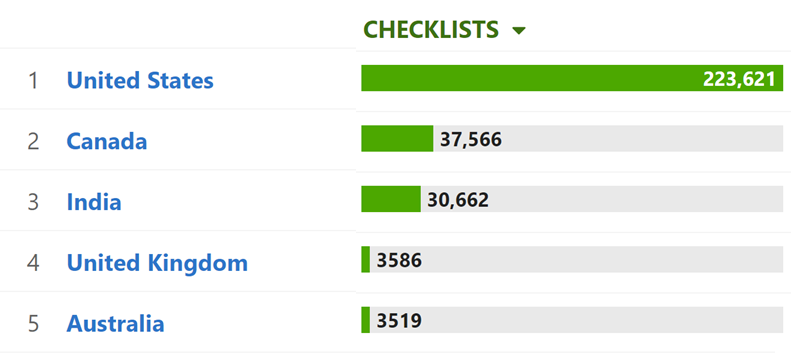
The number of checklists shown differs from that used for analysis.
GBBC India
Previously, during GBBC, a lot of birding was concentrated in the southern states of India but, this year there was a dramatic increase in participation from other parts of the country – particularly the Western Himalayas, Central India, and Gujarat.
In the map below, each list contributed to GBBC is shown as a translucent circle. Deeper yellow indicates overlapping circles, which signals more lists from that location.
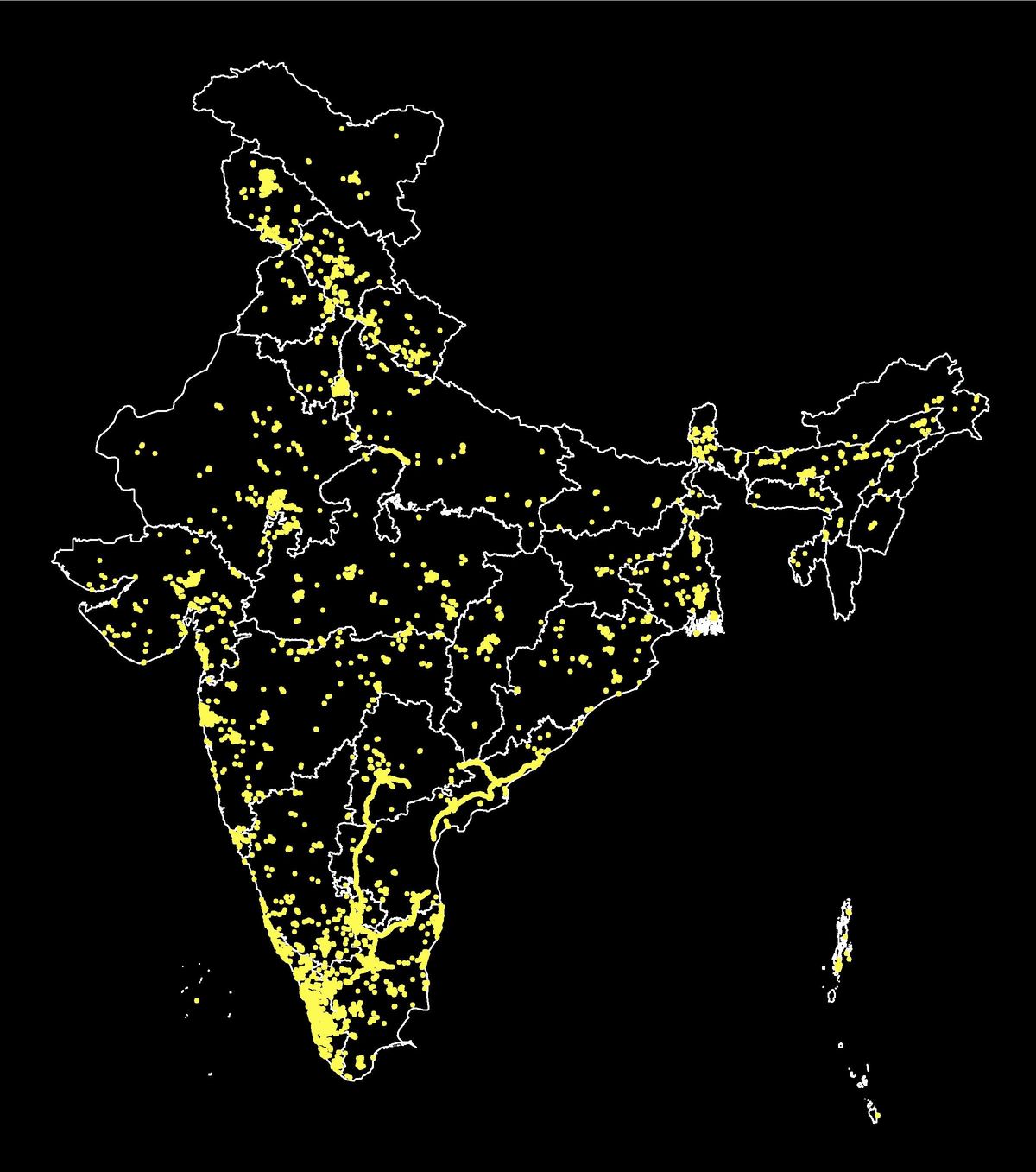
GBBC 2021 Coverage Map
The top three states in terms of checklists were Tamil Nadu, Kerala, and Karnataka. Tamil Nadu uploaded a whopping 11,293 checklists. Salem district in Tamil Nadu alone uploaded over 9,000 checklists during this GBBC!
Top states that uploaded over 100 lists
| State/ Union Territoris | Lists |
| Tamil Nadu | 11293 |
| Kerala | 6267 |
| Karnataka | 2284 |
| Maharashtra | 1731 |
| Andhra Pradesh | 1623 |
| Uttarakhand | 1335 |
| Jammu & Kashmir | 1095 |
| Madhya Pradesh | 935 |
| Gujarat | 699 |
| West Bengal | 586 |
| Assam | 485 |
| Telangana | 461 |
| Himachal Pradesh | 347 |
| Rajasthan | 339 |
| Chhattisgarh | 268 |
| Uttar Pradesh | 233 |
| Odisha | 195 |
| Delhi | 155 |
| Puducherry | 132 |
| Ladakh | 121 |
| Andaman & Nicobar | 112 |
| Haryana | 107 |
Top 15 districts in terms of lists uploaded
| District | Lists |
| Salem | 9290 |
| Idukki | 1328 |
| Alappuzha | 1156 |
| Dehradun | 1068 |
| Bangalore | 953 |
| Thrissur | 815 |
| Wayanad | 720 |
| Dakshina Kannada | 718 |
| Chennai | 550 |
| East Godavari | 502 |
| Palakkad | 429 |
| Ernakulam | 418 |
| Thiruvananthapuram | 400 |
| Ratnagiri | 369 |
| Jammu | 362 |
Top 10 states in terms of species recorded
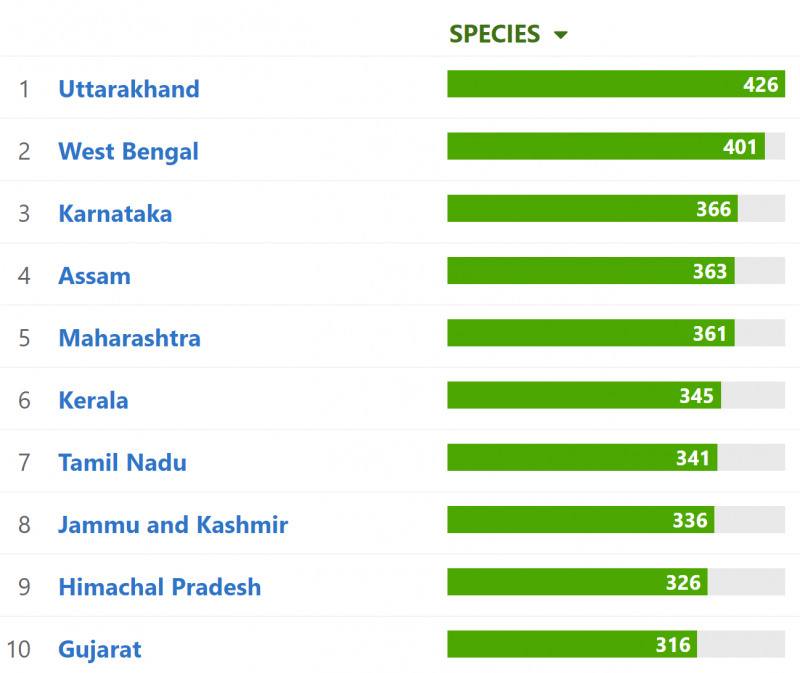
The number of species shown differs from that used for analysis.
Birders from Jammu & Kashmir uploaded 1095 lists – a tremendous increase from 84 in 2020. An amazing feat of coordination! Ladakh also, from 24 lists last year, had 121 this GBBC. There was a large increase in the number of lists uploaded from Uttar Pradesh, Gujarat, and Telangana. Madhya Pradesh had a remarkable increase in participation from 219 to 708 checklists this year. Bihar and Manipur too jumped from 4 lists in 2020 to 33 and 22 lists this year! Mizoram remains the only state in India without participation.
A special mention to the birders of Sikkim who participated in numbers and uploaded 56 checklists this year compared to none last year!
The state and district-level coverage of GBBC 2021 based on checklists are shown below. To view the summary (number of checklists, participants, species), please click on a state/ district in these zoomable maps.
GBBC 2021 State & Union Territory coverage
GBBC 2021 District coverage
P.S. The above maps are best viewed on a computer.
What are the most common species in India?
Just like last year’s GBBC, Common Myna was the most common bird in India (except in the western parts). In 2020, House Crow was the second most common species reported but this year it was replaced by the Red-vented Bulbul (38%) in the North, East, South, Central and West regions. The Rose-ringed Parakeet was previously common in the North and West, and this year in addition to both regions, it was also one of the common species reported in the South.
Comparing the 2020 and 2021 GBBC shows some interesting trends.
The Himalayas: The same species from last year were reported this year too with very little change in terms of their frequency of reporting.
North: Last year the reporting frequency of Black Kite was 78% but surprisingly this year it remained absent from the top 5 most common species. It was replaced by Red-vented Bulbul. Is it possible that the Black Kites have migrated locally earlier? An interesting hypothesis!
East: This year, Asian Pied Starling and Oriental Magpie-Robin were new amongst the top 5, replacing House Crow and Black Drongo.
Andaman & Nicobar Islands: Common Myna’s reporting frequency was 86% last year but this year it was only 49%. Another interesting thing to see is four new entrants into the top 5 – Asian Glossy Starling, Plume-toed Swiftlet, Olive-backed Sunbird and Pied Imperial-Pigeon. These four species replaced Red-whiskered Bulbul, Brown Shrike, Asian Koel, and House Crow from 2020. An increase in the number of birders, birding spread, and checklists uploaded in 2021 could have resulted in this amazing turnover!
South: House Crow, Common Myna, and Black Drongo continued as the top 3 but the Feral Pigeon and Large-billed Crow were replaced by Rose-ringed Parakeet and Red-vented Bulbul.
Central: The same species from last year remained on the list except for Purple Sunbird which was knocked out by Feral Pigeon.
West: The top 5 species remained the same as last year. However, the reporting frequency of Red-wattled Lapwing shot up from 42% to 61%. This is one of the most common species in many western states like Gujarat and Rajasthan. In some regions, it is known even from the busiest parts of cities enabling birders to observe nests and chicks. But note that there is no other part of the country it is so abundant!
The map shown below illustrates the 5 most common species in terms of their frequency of reporting, in seven broad regions in India.
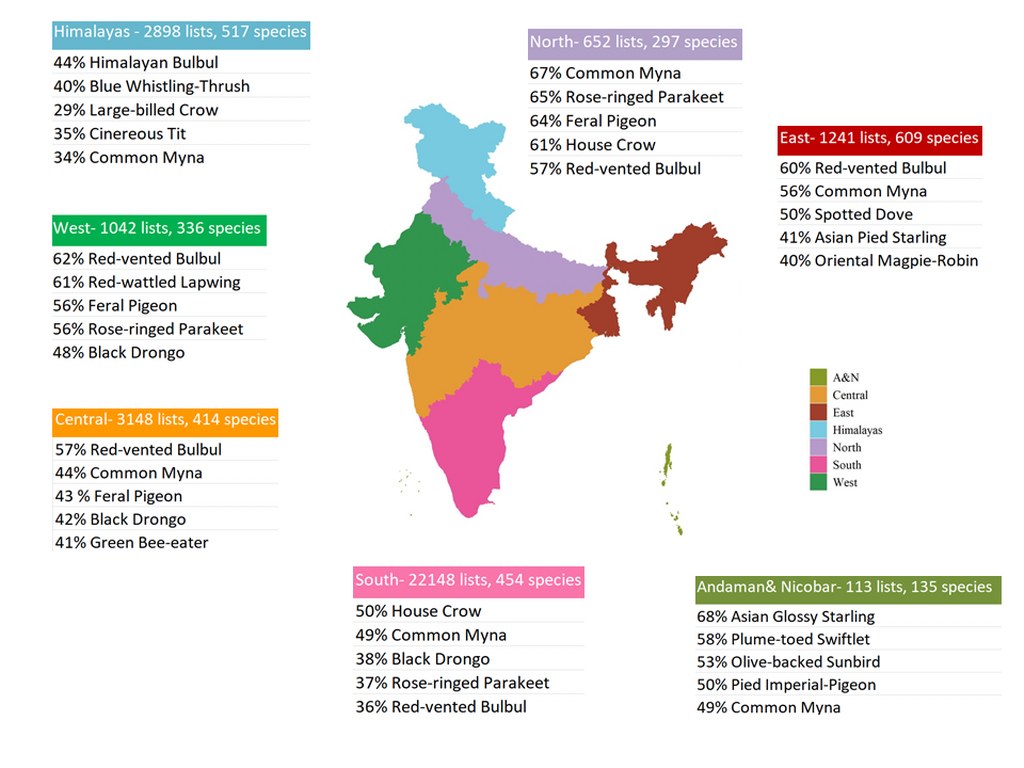
Here is a brief glimpse of lists and species recorded from each of the broad regions during this year’s GBBC (with the previous year’s GBBC numbers in brackets)
| Region | Lists | Species reported |
| A&N | 113 (31) | 135 (122) |
| Central | 3148 (1124) | 414 (473) |
| East | 1241 (590) | 609 (637) |
| Himalayas | 2898 (1458) | 517 (566) |
| North | 652 (406) | 297 (316) |
| South | 22148 (12173) | 454 (552) |
| West | 1042 (339) | 336 (378) |
Highlights for GBBC India 2021
Given the remarkable performance of India in GBBC 2021, we wish to highlight some of the most enthusiastic participants who uploaded checklists of 15-minute duration.
Top 30 birders in India in terms of number of 15 min checklists uploaded
| Participant Name | 15 min lists |
| Raj Guhan | 243 |
| Angeline Mano | 242 |
| Ganeshwar SV | 241 |
| Vasen Suli | 219 |
| Vasi | 211 |
| Renju TR | 208 |
| Venkatesh S | 202 |
| Abhin M Sunil | 190 |
| Harikrishnan C P | 166 |
| Sudheesh Mohan | 153 |
| Subramania Siva | 144 |
| Aiswaryalakshmi A R | 138 |
| Dilgith Surendran | 129 |
| Sneha Lakshmanan | 129 |
| Elavarasan M | 127 |
| Hari Kumar | 120 |
| Habeel Sahal | 115 |
| Malyasri Bhattacharya | 108 |
| Govind Girija | 105 |
| Vaishnav S | 105 |
| Abhirami C | 95 |
| Sakthi Chinnakannu | 94 |
| Franco P S | 90 |
| Maxim Rodrigues K | 86 |
| Sankar V | 86 |
| Vivek Hasyagar | 85 |
| Vishnu N | 83 |
| Padmavathy Matheswaran | 81 |
| Premchand Reghuvaran | 78 |
| Tubin Babu | 78 |
Top birders in each state, in terms of the number of 15 min checklists uploaded
| State/ UT | Participant Name | 15 min lists |
| Tamil Nadu | Raj Guhan | 243 |
| Kerala | Renju TR | 208 |
| Karnataka | Maxim Rodrigues K | 86 |
| Uttarakhand | Malyasri Bhattacharya | 80 |
| Jammu & Kashmir | Parvez Shagoo | 58 |
| Maharashtra | Priyanka Kadam | 56 |
| Gujarat | Irshad Theba | 55 |
| Andhra Pradesh | Janardhan Uppada | 46 |
| West Bengal | Upamanyu Chakraborty | 44 |
| Madhya Pradesh | Narendran M.M | 36 |
| Himachal Pradesh | Malyasri Bhattacharya | 28 |
| Chhattisgarh | Ajay Agarwal | 25 |
| Puducherry | Sandeep Kumar Reddy Gangasani | 24 |
| Uttar Pradesh | Pallavi Arora | 23 |
| Assam | Jigyas Boruah | 22 |
| Meghalaya | Aditya Banerjee | 22 |
| Odisha | Ajay Sarvagnam | 20 |
| Telangana | Pranay Juvvadi | 18 |
| Rajasthan | Ranjeet Singh | 17 |
| Andaman & Nicobar | Omkar Dharwadkar | 15 |
| Ladakh | Mohd Arhaan | 14 |
| Goa | Rahul Pereira | 11 |
| Punjab | Sanjiv Khanna | 11 |
| Sikkim | Rozan Dhungel | 9 |
| Delhi | Neal Fonseca | 8 |
| Haryana | Ronith Urs | 7 |
| Manipur | Dolly Bhardwaj | 7 |
| Nagaland | Rofikul Islam | 7 |
| Chandigarh | Vikas Sharma | 6 |
| Arunachal Pradesh | Rajesh Panwar | 5 |
| Bihar | Gyanchandra Gyani | 5 |
| Daman & Diu | Nirav Raval | 3 |
| Jharkhand | Rishabh Lohia | 2 |
| Dadra & Nagar Haveli | Saswat Mishra | 1 |
| Tripura | Rajdeep Deb Purkayastha | 1 |
So many more birders played a pivotal role in improving their regions’ participation in GBBC. A big thank you to all of you.
A shout out to Kashmir Birdwatch, Birds of Kashmir, J&K Birdlife, J& K Wildlife, Wildlife Conservation Fund, Wildlife Conservation, and Birds Club of Ladakh for their impressive efforts in coordinating, participating in this event and promoting birdwatching in JK and Ladakh.
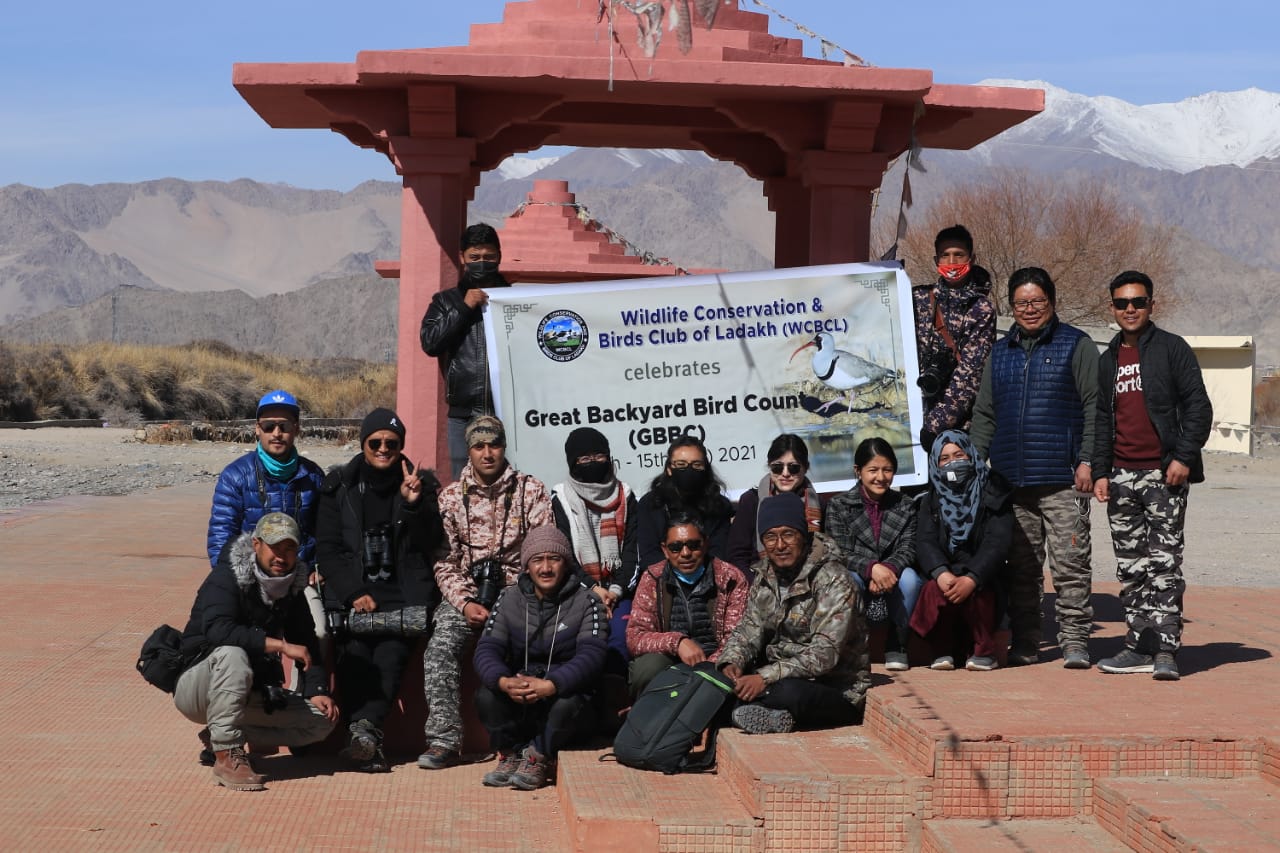
Members of Wildlife Conservation & Birds Club of Ladakh (WBBCL)
Campus Bird Count Results
The Campus Bird Count runs alongside GBBC in India, to record the birdlife in the multiple campuses across India and to promote birdwatching within institutions. Campuses include educational and training institutions, government institutions, research stations, corporate campuses, and so on. This year, a total of 143 campuses across India participated in the Campus Bird Count, uploading a total of 2,222 unique checklists.
Campus Bird Count coverage map
Table of top 15 campuses in terms of unique checklists uploaded
Table of top 15 campuses in terms of species reported
Table of top 15 campuses in terms of species reported
GBBC Bird Walks & Talks
Close to 3,000 birders participated in GBBC 2021, a 5 % increase from 2020. Many participants across the country led groups of schoolchildren and others on birdwatching walks. In Chhatisgarh, the CEFAC team took 30-40 people on birdwatching walks on all 4 four days of GBBC. During the walks, they were able to document 161 species and uploaded around 25 lists in eBird. In Mamurabad village, Jalgaon, Shilpa Gadgil did a poster presentation on general threats to birds. She also conducted a few birdwalks with children of brick-kiln workers. Members of Satpuda Nature Conservation Society from Jalgaon conducted birdwalks for kids and adults. The Nature Conservation Society in Nashik in collaboration with Yashwantrao Chavan Maharashtra Open University organised public birdwatching sessions on their university campus. In Uttarakhand, at Rajaji National Park, Ameer Hamza and Malyasri Bhattacharya took adults and children from the Van Gujjar community for birdwatching. To know more, read the stories here!
There were over 200 bird walks and talks organised across India, with a large number of school and college students and the larger public introduced to birding at educational and research campuses, lakes and other public spaces. The full list of registered events is here.
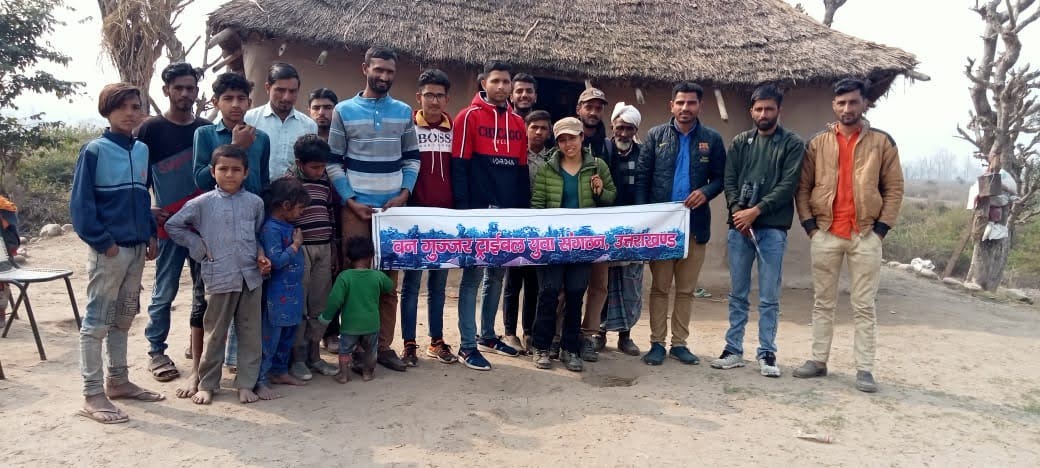
Photo by Aman Gujjar
GBBC/ CBC in the News
CBC in Mangalore University- 108 species recorded
CBC seen in seventeen campuses
CBC in Bodoland University
GBBC in Adarshgaon-Kiraksal
GBBC announcement in Bhusawal
Four-Day Great Backyard Count begins today
Further Information
GBBC 2021 was coordinated by Bird Count India and its various partners. For more information, see the following links.
- GBBC 2021: Stories from the field
- GBBC 2021 associated events (bird walks and talks)
- List of registered campuses
- GBBC Global
- GBBC 2021 in India
Bird Monitoring in India
- Visit the Bird Count India website
- Join the Facebook group
Contact Bird Count India at skimmer@birdcount.in
What Next?
GBBC will be back on 18-21 Feb 2022
In the meantime, keep eBirding and monitoring birds!
Subscribe here to get news and announcements about birds, birding, listing, and monitoring.
Banner Image is by Deepak

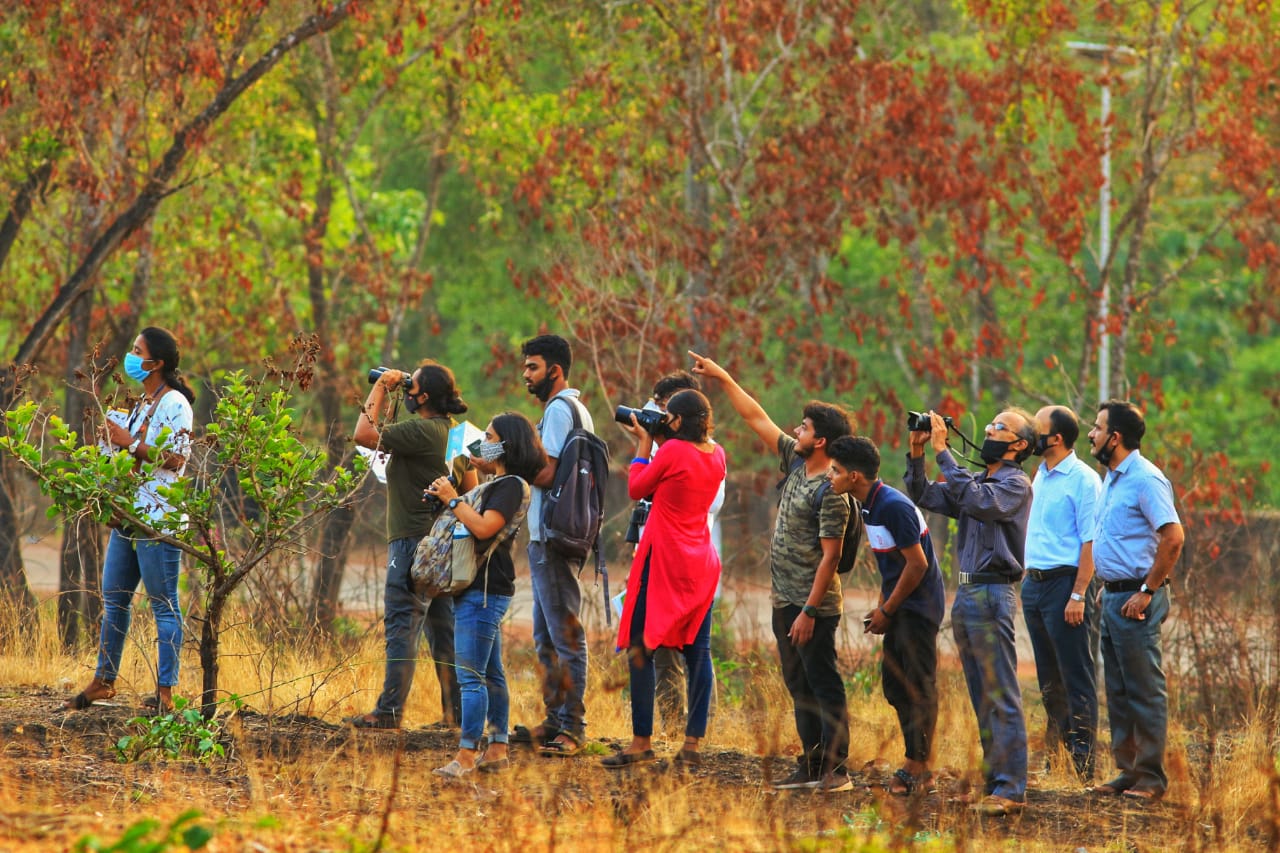

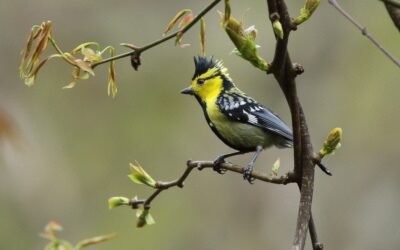

Amazing. Kudos to all the participants. Nice graphical visualization of results, too. Thanks.
wow, amazed . very well documented and very informative with interactive interface for understanding easily. thank you for all the efforts.